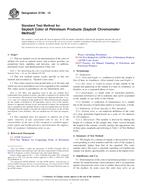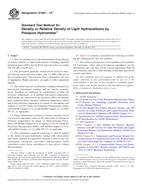We need your consent to use the individual data so that you can see information about your interests, among other things. Click "OK" to give your consent.
ASTM D3650-93(2011)
Standard Test Method for Comparison of Waterborne Petroleum Oils By Fluorescence Analysis (Withdrawn 2018)
Automatically translated name:
Standard Test Method for Comparison of Waterborne Petroleum Oils By Fluorescence Analysis
STANDARD published on 1.5.2011
The information about the standard:
Designation standards: ASTM D3650-93(2011)
Note: WITHDRAWN
Publication date standards: 1.5.2011
SKU: NS-24338
The number of pages: 5
Approximate weight : 15 g (0.03 lbs)
Country: American technical standard
Category: Technical standards ASTM
The category - similar standards:
Annotation of standard text ASTM D3650-93(2011) :
Keywords:
fluorescence spectral emission, fluorescence spectroscopy, oil identification, UV-VIS fluorescence, waterborne petroleum oils, Fluorescence--water analysis, Fluorescence spectrochemical analysis, Fuel oils, Oil identification, Oil spill control systems, Petroleum oils, Sampling containers, Sampling water analysis applications, Sand, Substrates, Ultraviolet (UV) analysis--water, Vegetation--plant tissues, Waterborne oils, ICS Number Code 75.080 (Petroleum products in general)
Additional information
| Significance and Use | ||||||||||||||||||
|
This test method is useful for rapid identification of waterborne petroleum oil samples as well as oil samples obtained from fuel or storage tanks, or from sand, vegetation, or other substrates. This test method is applicable to weathered and unweathered neat oil samples. The unknown oil is identified through the comparison of the fluorescence spectrum of the oil with the spectra (obtained at similar instrumental settings on the same instrument) of possible source samples. A match of the entire spectrum between the unknown and possible source sample indicates a common source. |
||||||||||||||||||
| 1. Scope | ||||||||||||||||||
|
1.1 This test method covers the comparison of waterborne petroleum oils with oils from possible sources by means of fluorescence spectroscopy (1). Useful references for this test method include: (2) and (3) for fluorescence analysis in general and (4), (5), and (6) for oil spill identification including fluorescence. 1.2 This test method is applicable to crude or refined petroleum products, for any sample of neat oil, waterborne oil, or sample of oil-soaked material. Unless the samples are collected soon after the spill occurs, it is not recommended that volatile fuels such as gasoline, kerosine, and No. 1 fuel oils be analyzed by this test method, because their fluorescence signatures change rapidly with weathering. Some No. 2 fuel oils and light crude oils may only be identifiable up to 2 days weathering, or less, depending on the severity of weathering. In general, samples weathered up to 1 week may be identified, although longer periods of weathering may be tolerated for heavy residual oils, oil weathered under Arctic conditions, or oil that has been protected from weathering by collecting in a thick layer. 1.3 The values stated in SI units are to be regarded as standard. No other units of measurement are included in this standard. 1.4 This standard does not purport to address all of the safety concerns, if any, associated with its use. It is the responsibility of the user of this standard to establish appropriate safety and health practices and determine the applicability of regulatory limitations prior to use. |
||||||||||||||||||
| 2. Referenced Documents | ||||||||||||||||||
|
Similar standards:
Historical
1.11.2012
Historical
1.6.2012
Historical
1.12.2013
Historical
1.6.2014
Historical
15.11.2010
Historical
1.6.2012
We recommend:
Updating of laws
Do you want to be sure about the validity of used regulations?
We offer you a solution so that you could use valid and updated legislative regulations.
Would you like to get more information? Look at this page.



 ASTM D156-12
ASTM D156-12 ASTM D1657-12e1
ASTM D1657-12e1 ASTM D1744-13
ASTM D1744-13 ASTM D1747-09(2014)..
ASTM D1747-09(2014).. ASTM D189-06(2010)e1..
ASTM D189-06(2010)e1.. ASTM D2008-12
ASTM D2008-12
 Cookies
Cookies
